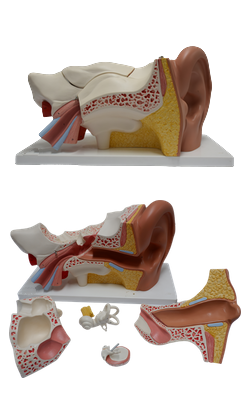Main Model

Internal ear : 21 Tensor veli palatini

Pharyngotympanic Tube
The pharyngotympanic tube (auditory tube) connects the tympanic cavity to the nasopharynx, where it opens posterior to the inferior nasal meatus. The posterolateral third of the tube is bony, and the remainder is cartilaginous. The pharyngotympanic tube is lined by mucous membrane that is continuous posteriorly with that of the tympanic cavity and anteriorly with that of the nasopharynx.
The function of the pharyngotympanic tube is to equalize pressure in the middle ear with the atmospheric pressure, thereby allowing free movement of the tympanic membrane. By allowing air to enter and leave the tympanic cavity, this tube balances the pressure on both sides of the membrane. Because the walls of the cartilaginous part of the tube are normally in apposition, the tube must be actively opened. The tube is opened by the expanding girth of the belly of the levator veli palatini as it contracts longitudinally, pushing against one wall while the tensor veli palatini pulls on the other. Because these are muscles of the soft palate, equalizing pressure (“popping the eardrums”) is commonly associated with activities such as yawning and swallowing.
Tensor veli palatini
Superior Attachment: Scaphoid fossa of medial pterygoid plate, spine of sphenoid bone, and cartilage of pharyngotympanic tube
Inferior Attachment: Palatine aponeurosis
Innervation: Medial pterygoid nerve (a branch of mandibular nerve, CN V3) via otic ganglion
Main Action(s): Tenses soft palate and opens mouth of pharyngotympanic tube during swallowing and yawning